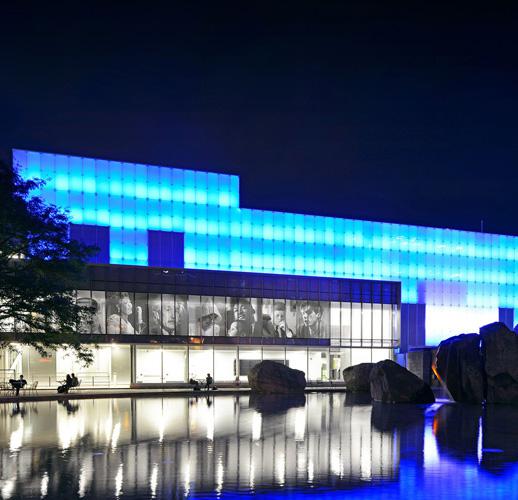The past 12 months, as usual, have seen a lot of activity in Canadian art institutions. Here’s a recap of some of the key stories.
In the lead, as in past years, is the fact that renovation and rebuilding continues to be a going concern for institutions across the country.
Over the past year, the Vancouver Art Gallery has continued its attempt to secure a space for a new, single stand-alone facility. Most recently, an artist committee was formed to help promote the idea to city council, who must be convinced of the project’s financial and social viability by February. The VAG also eliminated an annual deficit that it was dealing with last year, and this put it in a stronger position to make the case for relocating.
In Toronto, the Ryerson Image Centre opened in September to generally positive reviews.
Meanwhile, both Toronto and Vancouver were notified that major private institutions may be on the horizon: Collector David Mirvish announced plans for a Frank Gehry–designed gallery of his collection as part of a condo complex envisioned for Toronto’s King Street West, while collector Michael Audain was announced to be in talks to create a stand-alone gallery for his collection in Whistler. One major private institution—the Ydessa Hendeles Art Foundation—also closed this year, though Hendeles promises to continue curating and creating elsewhere.
In Winnipeg, the Winnipeg Art Gallery celebrated its 100th anniversary in part by moving forward with plans for a new Inuit Art and Learning Centre designed to highlight its extensive collection of Inuit art. The 40,000-square-foot space, estimated at $35 million, is due to begin construction in 2014. The architect, recently selected, is Michael Maltzan of Los Angeles, who has completed projects for MoMA QNS, Regen Projects and the Hammer Museum.
In Montreal, the Musée des beaux-arts announced another pavilion-building project (it just completed one last fall as well). This new pavilion, estimated at approximately $24.5 million, will house a recent donation of 75 old master paintings from Michal and Renata Hornstein. It is planned to be completed by 2017, the 375th birthday of Montreal.
The Remai Art Gallery in Saskatoon—an evolution of the Mendel Art Gallery due to open in 2015—also altered some of its gallery plans with the news that the Remais donated a $20 million collection of Picasso prints to the gallery, effectively doubling the value of its collection. As a result, a third-floor space in the new gallery will be dedicated to the Picasso gift and works of international modernity.
In Halifax, the Art Gallery of Nova Scotia geared up plans for its own new facility, confirming the desire in its most recent annual report.
Various smaller public galleries also opened new facilities this year, including the Judith & Norman Alix Art Gallery in Sarnia (formerly Gallery Lambton), the Peel Art Gallery Museum and Archives in Brampton and the Gordon Smith Gallery in Vancouver.
Those galleries that didn’t expand sometimes formed new partnerships and programs.
This year, the National Gallery expanded its partnership program to the Winnipeg Art Gallery and renewed its program with the Art Gallery of Alberta. (The WAG partnership will bring Janet Cardiff’s Forty-Part Motet and Christian Marclay’s The Clock to Winnipeg in 2013.) The NGC’s partnership with Toronto’s MOCCA is up for renewal in 2013.
In a bid of cooperation, January saw the Museum of Contemporary Art Calgary and the Institute of Modern and Contemporary Art there jointly announce that their two boards have signed a memorandum of understanding, which is their first step towards creating a new visual arts facility and a charitable foundation. As Nancy Tousley wrote in her report for our site, the agreement is the first step towards the “free-standing, world-class public art gallery devoted to modern and contemporary art that the cultural life of this burgeoning city has lacked.” On Calgary’s private-institutions front in June, the Esker Foundation opened its doors with a survey titled “The New Alberta Contemporaries.”
The Royal Ontario Museum and the Art Gallery of Ontario instituted late-night events to attract younger patrons and a different mood to the museums. Though already in practice for years at institutions like the Vancouver Art Gallery and the Musée d’art contemporain de Montréal, this type of evening program is a relatively new addition to the Toronto scene. AGO director Matthew Teitelbaum discussed the reasons behind the move in an interview with Canadian Art.
On the curatorial and directorial front, there were also a number of changes. Kitty Scott departed the Banff Centre to become curator of contemporary art at the Art Gallery of Ontario, while Michelle Jacques left the Art Gallery of Ontario to become chief curator at the Art Gallery of Greater Victoria.
Glenbow Museum director and CEO Kirstin Evenden departed following a number of media reports regarding the financial and HR profile of the museum. Donna Livingstone took over as interim CEO.
Gaetane Verna started her term as director at the Power Plant in Toronto in March; a few months later, the relatively new curator of programs Melanie O’Brian departed. She is now director/curator of the Simon Fraser University Gallery. In mid-June, Jon Davies, who had been assistant curator at the Power Plant for several years, left for Oakville Galleries to be assistant curator there. As of press time, the Power Plant’s curator of programs position is still vacant, though a couple of less senior positions have been filled.
On the educational front, NSCAD celebrated its 125th anniversary amid some turmoil for the institution, including large deficits, debts, and the resignation of its president.
Finally, a nonprofit some in the arts community regarded as an institution, the Canadian Conference for the Arts, closed operations, explaining it was due to a too-rapid drop in federal funding and expressing hope that its legacy would be taken up again in the future.

 Ryerson Image Centre, Toronto / Photo courtesy RIC
Ryerson Image Centre, Toronto / Photo courtesy RIC







